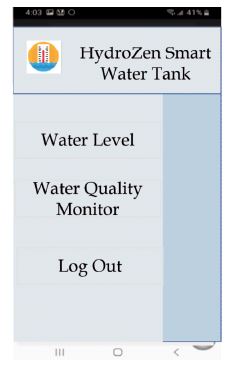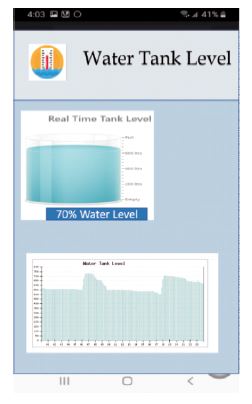
Figure 1. Block Diagram of HydroZen Smart Water Tank System
The HydroZen smart water tank system is a modern solution for managing water supply in households and other smallscale settings. It uses sensors and Internet of Things (IoT) technology to monitor the water level and quality in real time and provides users with up-to-date information through a user-friendly mobile application. The system also incorporates automated refilling and flushing processes to ensure that the water remains at an acceptable level and quality. With its simple installation and user-friendly interface, the HydroZen smart water tank system offers an efficient and convenient way to manage water supply and promote responsible water usage.
The integration of Internet of Things (IoT) technology in water storage and quality monitoring has revolutionized. By incorporating sensors and wireless connectivity, IoT systems can provide real-time monitoring of water levels, temperature, Potential of Hydrogen (pH) levels, and other parameters that affect water quality. This information can be accessed remotely using smartphones, tablets, or computers, allowing users to monitor and control their water storage systems from anywhere at any time.
One of the most significant benefits of IoT-based water storage and quality monitoring is the ability to prevent water wastage and optimize water usage. IoT systems can reduce wastage by monitoring the water level in a tank and automating the refilling process. This ensures that the tank is not overfilled, for instance. Similarly, by monitoring water quality, IoT systems can alert users when the water needs to be changed or purified, preventing unnecessary water usage.
In addition to improving efficiency and reducing wastage, IoT-based water storage, and quality monitoring can also help prevent waterborne diseases. By monitoring parameters such as temperature and pH levels, IoT systems can detect any changes in water quality that may indicate the presence of harmful bacteria or other contaminants. This information can then be used to take corrective action before the water is consumed.
HydroZen is an innovative water tank system that leverages IoT technology to provide advanced monitoring and automated refilling of water tanks. This system is designed to meet the growing demand for sustainable water management solutions that can help conserve water and reduce wastage.
The HydroZen system incorporates a range of sensors that can detect water level, temperature, and quality, and wirelessly transmit this information to a cloud-based platform. Users can access this information using a mobile application, which provides real-time updates on the status of the water tank, including the water level and quality.
One of the key features of the HydroZen system is its automated refilling capability, which ensures that the water tank is always full and ready for use. The system can be connected to a water source and an automated pump, which refills the tank whenever the water level falls below a certain threshold. Users can receive notifications on their mobile devices when the tank has been refilled, providing them with peace of mind and convenience.
The HydroZen system is a revolutionary solution in the field of water management, offering an innovative approach that can help users conserve water, reduce wastage, and improve overall efficiency.
Ramakala et al. (2017) presents a case study on the impact of Information and Communication Technologies (ICT) and Internet of Things (IoT) strategies for water sustainability in Rajapalayam, India. The study analyzes the current water management practices, identifies the challenges faced, and proposes a smart water management system using ICT and IoT. The proposed system includes sensors for monitoring water quality and quantity, a cloud-based platform for data storage and analysis, and an Android application for the user interface. The study concludes that the implementation of the proposed system can improve water sustainability, reduce wastage, and enhance water management practices.
Prasad et al. (2015) discusses the design and implementation of a smart water quality monitoring system using IoT technology. The system is equipped with sensors that measure parameters such as pH level, temperature, and turbidity of the water, and transmits the data wirelessly to a cloud-based server for analysis. The authors also developed a mobile application for users to monitor water quality in real time and receive alerts if the water quality falls below a certain threshold. The system is designed to be cost-effective and scalable, making it suitable for deployment in various settings.
Jan et al. (2021), WHO (2011) provides guidelines and recommendations for the safety and quality of drinking water, including information on the health risks associated with various contaminants in water. The guidelines are intended to assist countries in the development of national standards and regulations for drinking water quality, with the ultimate goal of protecting public health.
Kumar et al. (2019) the paper describes an IoT-based smart water microgrid and smart water tank management system. The system includes various sensors to monitor water quality, water level, and pump status. The data collected by the sensors is transmitted to a cloud server and processed by a machine learning algorithm. The system also includes a mobile application that allows users to monitor the water level, quality, and pump status remotely. The proposed system has the potential to reduce water wastage and improve water management in homes and industries.
Wadekar et al. (2016) discusses the development of a smart water management system using IoT. The system includes sensors that monitor the water level, quality, and temperature in real-time and sends the data to a cloudbased server. The user can access the information through a mobile application and control the water flow using the app. The system also includes a water quality monitoring system to detect impurities and alert the user. The proposed system aims to reduce water wastage and improve water management efficiency.
Rajurkar et al. (2017) describes an Internet of Things (IoT) based water management system that aims to reduce water wastage and optimize water usage. The system consists of sensors and a microcontroller that collect data on water flow and quality, which is then transmitted to a cloud-based server for analysis. The system also includes a mobile application for user access to real-time water data and alerts. This paper suggests that the IoT-based water management system can be applied in various settings, including households, industries, and agriculture, to promote sustainable water management practices.
González-Vidal et al. (2019) proposes an Internet of Things (IoT) based solution for water management that utilizes machine learning algorithms for intelligent anomaly detection. The proposed system is designed to monitor water consumption, detect anomalies, and predict future water usage based on historical data. The system consists of sensors that collect water usage data, a gateway that processes and transmits the data to the cloud, and a machine learning model that analyzes the data to detect anomalies and predict future usage. The system is tested in a real-world scenario, and the results show that the proposed solution can accurately detect anomalies and predict future usage, which can help in reducing water wastage and improve water management.
Figure 1 illustrates the components of the HydroZen smart water tank system and their connections. The water tank is connected to two sensors - an ultrasonic sensor and a water quality sensor. The ultrasonic sensor measures the level of water in the tank, while the water quality sensor measures the quality of water. These sensors are connected to a microcontroller, which processes the data and sends it to the Wi-Fi module.

Figure 1. Block Diagram of HydroZen Smart Water Tank System
The Wi-Fi module is responsible for transmitting the data to the Android application, which is used to monitor and control the system. The Android application provides realtime information about the water level and quality, as well as the ability to control the system remotely.
Figure 2 shows the workflow of the proposed HydroZen smart water tank system. If the water level is not below 20% of water level and the water quality is within acceptable parameters, the system will continue to monitor the water level and quality. If the water level falls below the minimum threshold, the system will proceed, which involves initiating the automated refilling process.
Once the system determines that the water level needs to be refilled, it will check if it is connected to a water supply source. The system will proceed to check if the water supply source is available and an automated refilling process will be initiated.
During the refilling process, the system will monitor the water quality to ensure it remains within acceptable parameters. If the water quality is not acceptable, the refilling process will be aborted, and an alert will be sent to the user. Once the refilling process is complete, the system will update the water level. The water quality parameter discussed as follows.
If the water level is above the maximum threshold i.e., 80%, the refilling process will be stopped, and an alert will be sent to the user. Otherwise, the system will continue to monitor the water level and quality.
Figure 3 shows the HydroZen smart water tank system's main screen it provides the user with the current status of the water level and quality of the water.

Figure 3. Main Screen of HydroZen Smart Water Tank
Figure 4 displays the real-time water level of the water tank. The system will update the tank level every minute using data from the sensors connected to the microcontroller. The dashboard will also include a graph that plots the water level readings. The y-axis of the graph will indicate the volume of water in the tank, and the x-axis will denote the hour of the day. This will allow the user to monitor their water usage patterns and make informed decisions about their water consumption.

Figure 4. Water Tank Level Monitor
Figure 5 displays of the water quality parameters, including pH, temperature, turbidity, and dissolved oxygen. If any of these parameters fall outside the acceptable range, the system will indicate that the water quality is poor and not suitable for consumption. The user can activate the flush water function by clicking on the button displayed on the system's interface. The flush water function will release the water in the tank and refill it with fresh water until the quality parameters return to acceptable levels.

Figure 5. Water Quality Monitor
The complete experimental setup of the HydroZen smart water tank system is shown in Figure 6.

Figure 6. Implementation of Proposed System
The HydroZen smart water tank system is a comprehensive solution for effectively managing water resources in a household or commercial setting. By providing real-time data on water levels and quality, the system enables users to proactively manage their water usage, reduce wastage, and promote sustainability. The automated refilling processes further ensure that the tank is always adequately filled, and the water quality remains within acceptable parameters. This system is a valuable tool for any home or business that seeks to optimize its water management practices and promote environmental responsibility.